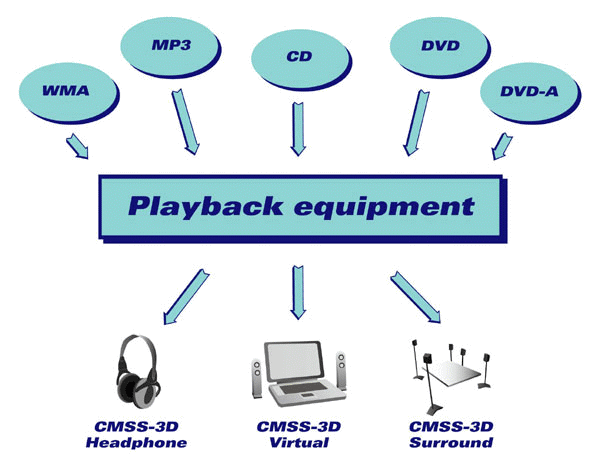Creative X-Fi: A New World of Sound
CMSS 3D: From Stereo To Surround
With surround sound becoming common for consumer listening, plain stereo - though still the most widespread sound format for music - is beginning to look a bit obsolete. If you're in the habit of listening to 5.1 (or better) surround, you probably often find stereo somewhat "thin." And it's also a little frustrating to use only two channels when you have a multichannel system.
CMSS, which Creative has already offered for some time now, was designed (like other similar technologies) to solve this problem by "upmixing" two channels to 5.1 or 7.1 surround sound. Until now, the results have been only partially successful. But thanks to the processing power of X-Fi, the operation - called CMSS-3D - now produces much better results. We described its operating principle in our earlier article :
In practice, the X-Fi version of CMSS 3D has several modes, depending on your equipment and the type of source being processed. The first upmixes stereo to 5.1 or 7.1, but it can also create a virtual surround experience if you have only two speakers. Finally, it considerably improves headphone listening, as we'll see later.

CMSS-3D is very effective when upmixing a stereo source to multichannel, because it both recreates the ambient sound of a recording, and preserves the center of the sound image thanks to the center channel. In a typical recording, the singer will be perfectly centered in the soundstage and won't "wander" due to imprecision in the recording or the reproduction. On the other hand, obviously CMSS-3D's upmix of a stereo source is not comparable to a true multichannel recording. Effects created by the sound engineer won't appear by magic. This is clear if you listen to recordings that exist in both versions - like the Jean-Michel Jarre album Aero , or Feels Like Home by Norah Jones. Still, the reproduction of ambience in a recording can be spectacular; it all depends on what was originally recorded. And in that respect, old recordings you may have thought you knew well can reveal some hidden treasures. Since they tend not to have been made in today's totally aseptic recording studios, they contain ambience information that's particularly interesting to hear when it's rendered realistically. This can apply to all live recordings such as opera.
Stay on the Cutting Edge
Join the experts who read Tom's Hardware for the inside track on enthusiast PC tech news — and have for over 25 years. We'll send breaking news and in-depth reviews of CPUs, GPUs, AI, maker hardware and more straight to your inbox.
Current page: CMSS 3D: From Stereo To Surround
Prev Page Crystalizer: Truer Sound Next Page For DivXMost Popular

